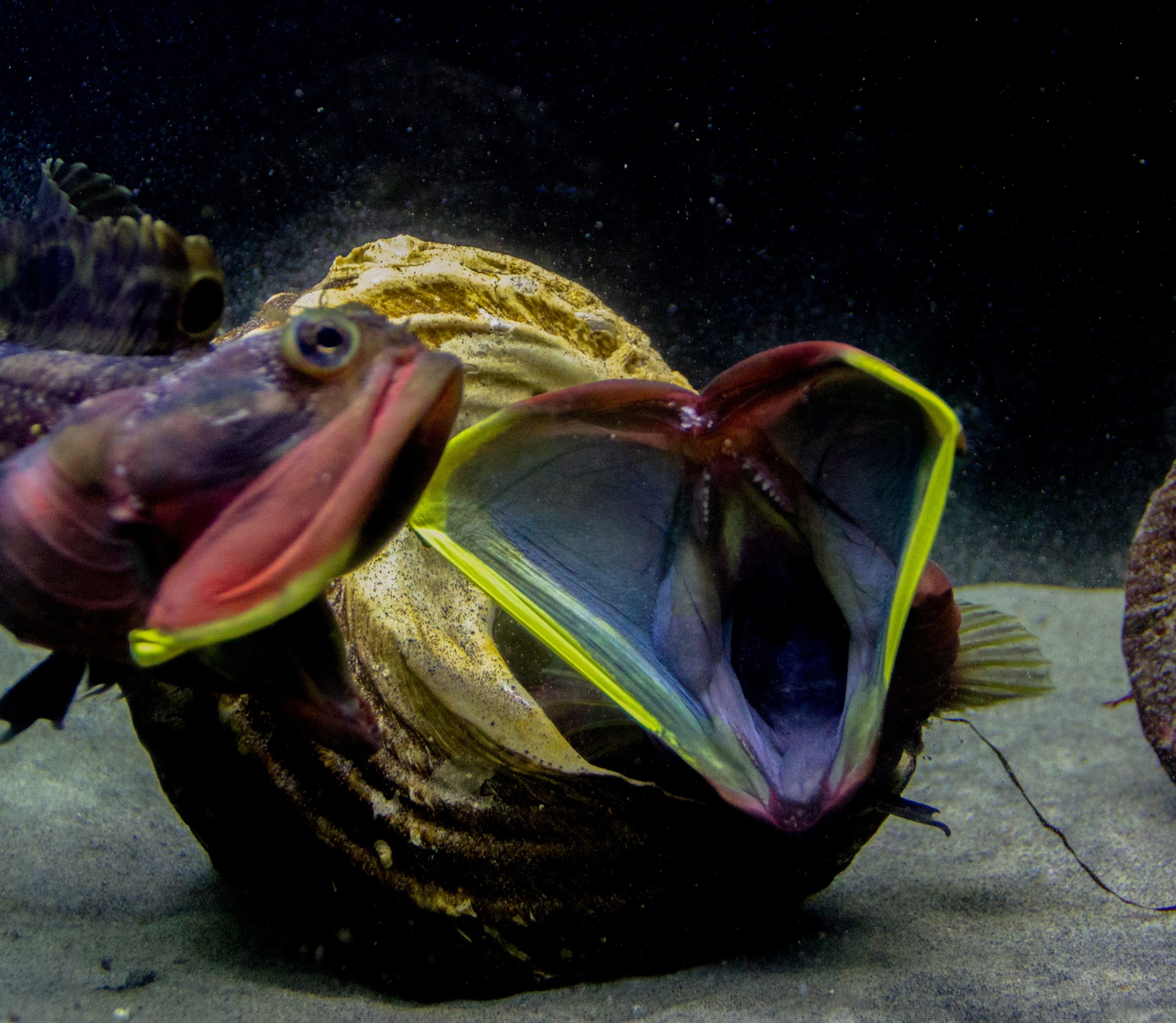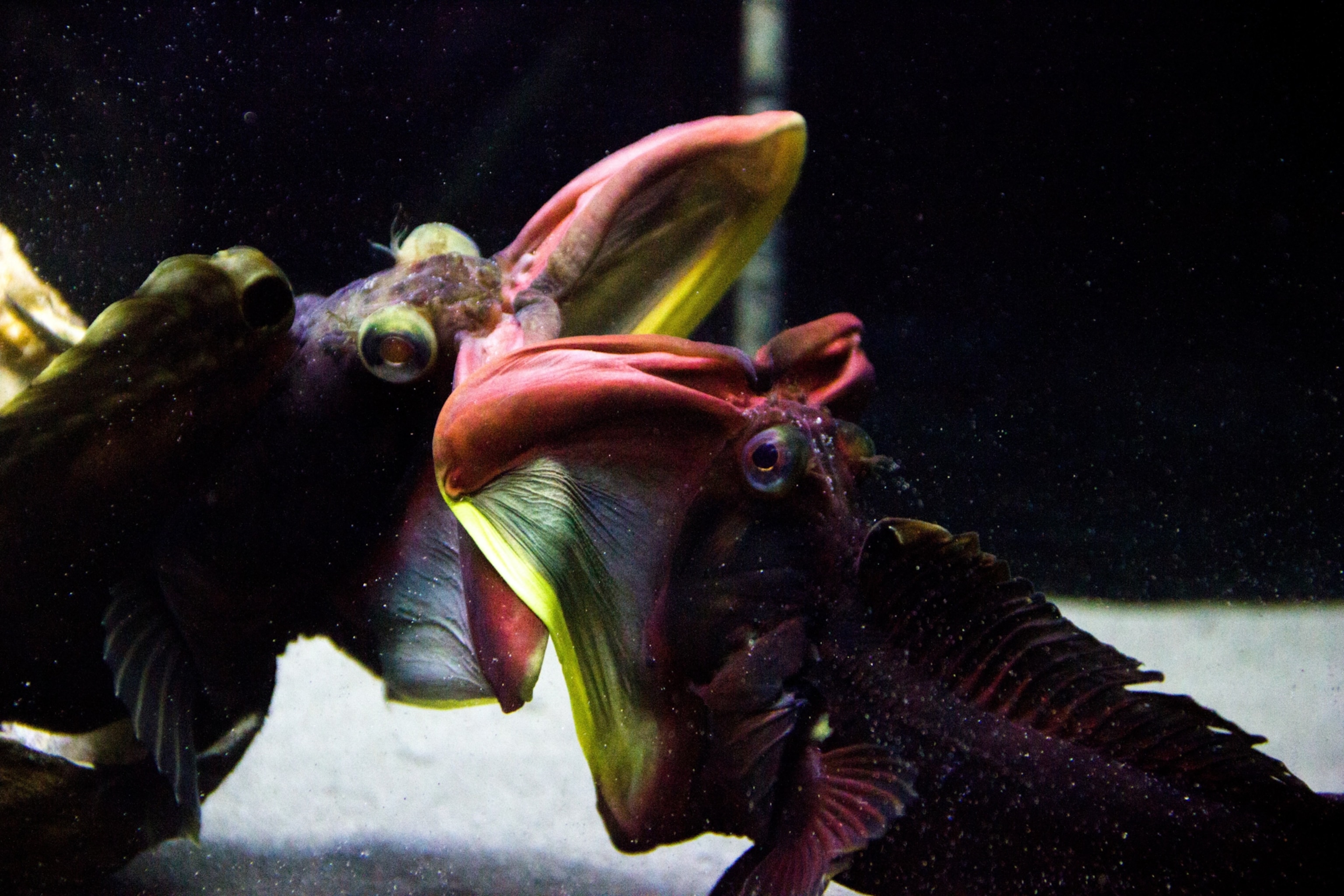
Why these colorful fish engage in mouth-to-mouth showdowns
Colorful fish called sarcastic fringeheads have incredible confrontations where they open their fluorescent mouths. Research suggests these displays may help avoid fights.
When they meet, sarcastic fringeheads can get mouthy. These bug-eyed, bright-lipped fish often open their giant jaws to show off the psychedelic hues splashed across the inside of their mouths. And they can get into fights.
“This species has a very wide gape, which means they might have evolved to have some special function,” says Watcharapong Hongjamrassilp, a biologist at Chulalongkorn University in Bangkok, Thailand, and a National Geographic Explorer. They are able to open so widely due to their special jawbones, which can extend far past their faces, unlike those in most fish.
But why these creatures have such loud mouths and what they use them for hasn’t been clear. Now, new research published October 6 in Ecology suggests that these displays may advertise a male’s size and fitness and help prevent physical fights that could cause injuries.
Shelter battles
With their brilliant colors, sarcastic fringeheads (Neoclinus blanchardi) reminded Hongjamrassilp of peacocks. In this fish species, both males and females gape their mouths. But females are smaller and their mouths’ colors are muted compared with males. Hongjamrassilp’s team wondered whether males open wide to dazzle females or compete with other males.
On scuba dives, Hongjamrassilp and his colleagues observed sarcastic fringeheads at a couple of spots off the coast of California, where the bottom-dwelling fish typically hang out in shells or rock crevices. Most of the time, the fish hid in their shelters with only their heads peeking out. When an intruder—other types of fish or octopuses—came too close, the feisty fishes would chase them off and sometimes attack. But when the passerby was another of the same species, the resident fish often gaped its mouth.
The researchers trapped 15 sarcastic fringehead males and brought them back to the lab, where they staged fish meetups. They put two males in a tank with only one snail shell. After one male took command of the shell, the scientists watched how they interacted.
Male sarcastic fringeheads defend these sorts of shelters, which are key to how these fish reproduce, says Philip Hastings, a marine biologist at Scripps Institution of Oceanography in La Jolla, Calif., who was part of this work. Males court females at shelters and a receptive female will lay her eggs there. The male fertilizes the eggs and continues to guard them.
“So that’s why they fight over the shelters pretty intensively,” Hastings says. “If a male doesn’t have one of these sites, he’s not going to reproduce at all.”
In nearly 70 percent of encounters, the male went full-on gape when the other fish approached. Then, the interloper would either retreat or the pair would fight, swimming at each other, agape, before engaging in mouth-to-mouth combat.
The lipsmacking showdowns eventually concluded when the winning fish managed to bite its opponent. Bites were often to the head, and such wounds can become infected, Hongjamrassilp says. The bigger fish, with larger jaws, tended to win these contests.
Both in the wild and in the lab, the team didn’t see males gaping wide at females. Instead, they appear to court them with headshaking. Altogether, the observations suggest that males’ splayed open jaws serve primarily to communicate with other males, the team reports.
An alternative to fighting?
Researchers often consider an animal’s gape as the limiting factor in what it can eat, says Peter Hundt, an ichthyologist at the University of Minnesota in St. Paul. But that explanation doesn’t seem to fit for the sarcastic fringehead’s outstretched jaws. “This fish does not need this big of a mouth to eat what it’s eating—something else is going on.”
Brandishing their big jaws may instead be a way to advertise body size, which could dissuade another male from getting physical, the researchers suggest. The fish have sharp front teeth that can cause damage to an opponent’s sensory organs or the eponymous head fringe.
“We think that this behavior allows them to decrease the rate of fighting,” Hongjamrassilp says.

It’s a compelling idea, says Hundt. There’s a lot of fish swimming around with battle scars from competing over food or other resources, he says.
“There would be an advantage to not actually combating and actually just settling it with the with the size of your mouth.” But the number of observations was limited, he says. So the team should gather more observations, he says, especially in the wild, to be certain they aren’t missing aspects of the behavior.
Previously, the researchers observed that sarcastic fringeheads’ mouth membranes reflect UV light and that parts of them also fluoresce, for instance, glowing green when light of a certain wavelength falls on them.
Hongjamrassilp first saw this when he was working with the fish in a lab that contained a coral tank lit up by a UV light-emitting blacklight.
“I was so excited to see that,” he says. Those features may further accentuate the umbrella-like open mouth and enhance its visibility. “In this case, you have maybe something that originally evolved as a weapon becoming more of a signaling device,” says Matthew Kolmann, an integrative biologist at the University of Louisville in Kentucky who wasn’t involved with the work.
The team is now investigating how the gaping behavior and the big jaws behind it evolved. Hongjamrassilp is comparing the behavior of sarcastic fringeheads with related species in Japan that have less colorful and wide mouths. Mapping the details of how these fishes use their mouths onto a tree of evolutionary relationships could help to reveal whether having big mouths helps to drive the gaping behavior or vice versa.
Many fishes from different groups gape, Kolmann says. “But these things take it to the nth degree.” Kolmann is curious whether other fishes use gaping displays in a similar way as sarcastic fringeheads.
“Who in their right mind would have thought that two males would fight each other by blowing parts of their skulls out?” Kolmann asks. “This is just an incredible example of the diversity on Earth.”
Related Topics
You May Also Like
Go Further
Animals
- Why we may soon see more Arctic hybrids like the pizzlyWhy we may soon see more Arctic hybrids like the pizzly
- Komodo dragons have iron-coated teeth—never before seen in reptilesKomodo dragons have iron-coated teeth—never before seen in reptiles
- Dragonflies can reveal mercury contamination. Here's how.Dragonflies can reveal mercury contamination. Here's how.
- Sharks found with cocaine in their systems. How did that happen?Sharks found with cocaine in their systems. How did that happen?
Environment
- Beat the heat with these innovative AC alternativesBeat the heat with these innovative AC alternatives
- Why some surfers aren't happy the 2024 Olympics are in TahitiWhy some surfers aren't happy the 2024 Olympics are in Tahiti
- Is climate change putting the lobster roll in jeopardy?Is climate change putting the lobster roll in jeopardy?
- 2024 Olympics may be hottest ever—are athletes prepared?2024 Olympics may be hottest ever—are athletes prepared?
History & Culture
- Who killed Germanicus, the golden boy of ancient Rome?Who killed Germanicus, the golden boy of ancient Rome?
- We're still dealing with the pandemic's scars, psychologists sayWe're still dealing with the pandemic's scars, psychologists say
Science
- Will a new colon cancer blood test replace your colonoscopy?Will a new colon cancer blood test replace your colonoscopy?
- Too much corn is bad for you—and it’s in nearly everything we eatToo much corn is bad for you—and it’s in nearly everything we eat
- There are 6 known forms of depression. Here’s how they differ.There are 6 known forms of depression. Here’s how they differ.
- A hydrothermal blast rocked Yellowstone. It won’t be the last.A hydrothermal blast rocked Yellowstone. It won’t be the last.
- How wildfires unleash fire clouds—and even fire tornadoesHow wildfires unleash fire clouds—and even fire tornadoes
- How boredom can help you reach your creative potentialHow boredom can help you reach your creative potential
Travel
- Pittsburgh has 700 staircases that offer the perfect view for urban hikersPittsburgh has 700 staircases that offer the perfect view for urban hikers
- The Mystic side of Maine is found in fairies, desert sands, and an unexpected boat tour
- Paid Content
The Mystic side of Maine is found in fairies, desert sands, and an unexpected boat tour - Ultimate Highway 90 guide: Best attractions, eats, and staysUltimate Highway 90 guide: Best attractions, eats, and stays
- In Maine, the escape to nature is a lifestyle
- Paid Content
In Maine, the escape to nature is a lifestyle






